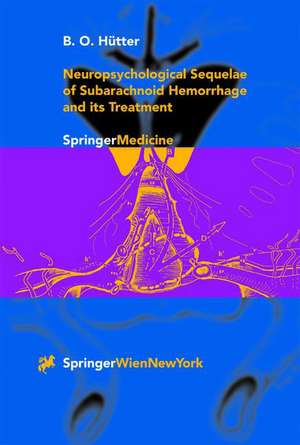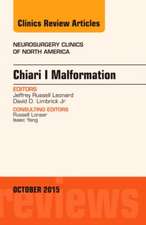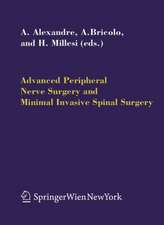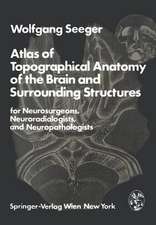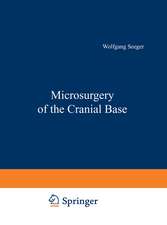Neuropsychological Sequelae of Subarachnoid Hemorrhage and its Treatment
Autor B.O. Hütter Cuvânt înainte de W. Seeger, K. Poecken Limba Engleză Paperback – 10 aug 2000
Preț: 710.23 lei
Preț vechi: 747.61 lei
-5% Nou
Puncte Express: 1065
Preț estimativ în valută:
135.90€ • 142.27$ • 112.45£
135.90€ • 142.27$ • 112.45£
Carte tipărită la comandă
Livrare economică 05-19 aprilie
Preluare comenzi: 021 569.72.76
Specificații
ISBN-13: 9783211834428
ISBN-10: 3211834427
Pagini: 200
Ilustrații: XVI, 178 p. 6 illus.
Dimensiuni: 170 x 244 x 11 mm
Greutate: 0.28 kg
Ediția:2000
Editura: SPRINGER VIENNA
Colecția Springer
Locul publicării:Vienna, Austria
ISBN-10: 3211834427
Pagini: 200
Ilustrații: XVI, 178 p. 6 illus.
Dimensiuni: 170 x 244 x 11 mm
Greutate: 0.28 kg
Ediția:2000
Editura: SPRINGER VIENNA
Colecția Springer
Locul publicării:Vienna, Austria
Public țintă
Professional/practitionerCuprins
1. Introduction.- 2. Clinical appearance, pathology and diagnostics of subarachnoid hemorrhage (SAH).- 2.1. Definition, epidemiology and etiology.- 2.2. Epidemiology of SAH as a result of the rupture of an aneurysm and of spontaneous SAH without a proven source of the bleeding.- 2.3. Pathophysiology of SAH.- 2.4. Clinical features of acute SAH.- 2.5. Diagnostics of acute SAH.- 2.6. The most common classification systems to assess the state of a patient and the severity of SAH.- 2.7. Natural course of SAH.- 3. Therapy of SAH.- 3.1. General principles.- 3.2. Operative therapy of ruptured intracranial aneurysms.- 3.3. Postoperative mortality after aneurysm rupture.- 4. Special aspects of the pathology and therapy of SAH.- 4.1. The importance of the anatomical distribution of the hemorrhage.- 4.2. Intraventricular hemorrhage.- 4.3. Intracerebral hemorrhage.- 5. Cerebral vasospasm after SAH.- 6. Early surgery of patients grade IV or V after Hunt and Hess.- 7. Neuropsychological sequelae of SAH.- 7.1. Early studies on the neuropsychological sequelae of SAH.- 7.2. The discrepancy between a good neurological state and the neuropsychological impairments in patients after SAH.- 8. Basics of scientific research on the neuropsychological sequelae of subarachnoid hemorrhage.- 8.1. General methodological considerations.- 8.2. Strengths and weakness of neuropsychological measures in patients after SAH.- 8.3. The measurement of health-related quality of life of patients after SAH by means of the Aachen Life Quality Inventory (ALQI).- 8.4. Disturbances of affectivity and personality in patients after brain damage.- 8.5. The assessment of psychological adjustment after SAH by means of the revised Freiburger Personality Inventory (FPI-R).- 9. The pattern of cognitive deficits in the chronic state after subarachnoid hemorrhage.- 9.1. Impact on general intelligence.- 9.2. Cognitive deficits after SAH.- 10. Neuropsychological effects of aneurysm location.- 10.1. Are there specific neurobehavioral sequelae depending on the localization of the ruptured aneurysm?.- 10.2. Disconnection syndromes after aneurysm rupture.- 10.3. Cognitive deficits after rupture and surgical treatment of an aneurysm of the ACoA.- 11. Impairments in daily life after SAH.- 12. Psychological adjustment and depression after SAH.- 13. Ability to work and professional performance capacity in patients after SAH.- 14. Neurobehavioral sequelae of SAH without a proven source of the bleeding in comparison to the sequelae of the rupture of an intracranial aneurysm.- 14.1. Comparison of the cognitive deficits in both patient groups.- 14.2. Comparison of the impairments in quality of life between operated patients and those with SAH without a proven source of the bleeding...- 15. Neuropsychological sequelae of aneurysm surgery.- 16. Neurobehavioral sequelae of the anatomical bleeding pattern.- 17. Short- and long-term effects of disturbed CSF circulation after SAH.- 18. Health-related quality of life in patients who had been in Hunt and Hess grades IV or V on admission to the neurosurgical unit.- 19. Vasospasm: a risk factor for neuropsychological impairments after SAH?.- 20. Prognostic factors of the neurobehavioral late result after SAH.- 21. SAH as a psychological trauma.- 22. Problems of rehabilitation of patients after SAH.- 22.1. Spontaneous functional regeneration after SAH.- 22.2. General elements of rehabilitation after SAH.- 22.3. Scientific studies on the effectiveness of neuropsychological rehabilitation measures in patients after SAH.- 23. Closing discussion and outlook.- 24. References.
Caracteristici
The quality of life after SAH is becoming more and more important Provides a broad survey of the neuropsychological consequences The author gives special attention to psychological trauma
